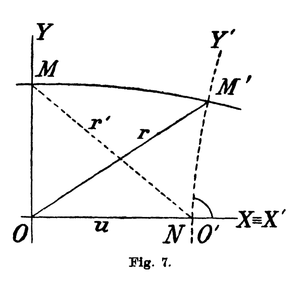coordinate system S, in which observer M (as he thinks) is at rest. However, if we move the coordinate origin to O', i.e., if we take as the fundamental system , then and all points of the new ordinate axis will be transformed into the state of rest. However, also the time parameter is changed by that transformation.

The unit time of the observer at a specific point shall be represented by the hyperbolic cosine of the Lobachevskian abscissa of that point. The unit time of the observer in O or in M is equal to "1" in the unprimed system, while the unit time of the observer in O'(M') becomes equal to , if we put OO' = u. For the observer resting in O it appears that the clock moving with velocity u stays behind in the ratio . When evaluating the duration of an event by means of the moving clock, the resting observer will find a smaller number. Thus there is the relation
| (39) |
or
However, in the primed system the unit time of the observer in is equal to "1", while the unit time of the observer in O is equal to . Both systems are completely and equally justified. Thus we cannot speak of a time duration per se. Consequently it is not allowed to speak about the simultaneity of two events in an absolute sense.

At first let us consider an example.[1] From a material point A at rest at the coordinate origin in a valid reference frame, a short light signal propagates in all directions at time l = 1. At time l > 1 the points that receive the signal are located on a sphere, of which we only want to consider the intersection circle with the XY-plane. On this circle two other material Points B and C at rest in S, may be located; therefore they simultaneously receive the signal, that is, by the same value l.
- ↑ M. Laue, Das Relativitätsprinzip, 1911, 35. M. Planck, Acht Vorlesungen über theoretische Physik, 1910, 118.








